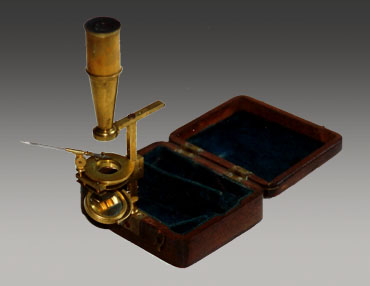
Cary-Gould Pocket Microscope
London, England
c. 1840.
When we think of microscopes today, we visualize large, heavy instruments on formica tables in laboratories or classrooms. Nearly 200 years ago, small brass microscopes in mahogany boxes were available that would fit in a pants pocket. These instruments made in London catered to the backyard botanist and curious field explorers of the time. Some of the most popular and of high quality were those produced by Charles Gould at the shop owned by William Cary.
William Cary (1759-1825) became a maker of scientific instruments in 1785, producing high quality examples of sextants, microscopes, telescopes, and other scientific instruments. He operated his business at 181 Strand in London until his building was completely destroyed by fire in 1820. He then opened his shop down the road at 277 Strand until his death five years later.
Cary had hired Charles Gould, an experienced optician to be the manager and head machinist of the business. Although the business still carried the Cary name after his death, Gould was considered the inventor of the microscopes offered.
In 1826, Gould’s new patented portable compound microscope was announced in the London Mechanic’s Register. The parts to this small brass device fit into a felt-lined mahogany box which measured 3 ¾” x 3″ x 1 ¼”. Assembled, the microscope stood 6 1/2″ from the aperture in the box edge. It came with additional screw-on lenses and small tools for collecting specimens. It retailed for 1 pound, 15 shillings, which would be about $150.00 in today’s exchange rate.
Gould continued to make improvements on his line of popular field microscopes. He also issued slides of prepared specimens of curious objects. Larger microscopes were also among Gould’s inventions, and were offered at the shop until Gould’s death in 1849 of cholera.
The specimen acquired by the museum is an 1840 model of Gould’s compact design, which was purchased at a Sotheby’s auction. It has since been sold at auction.